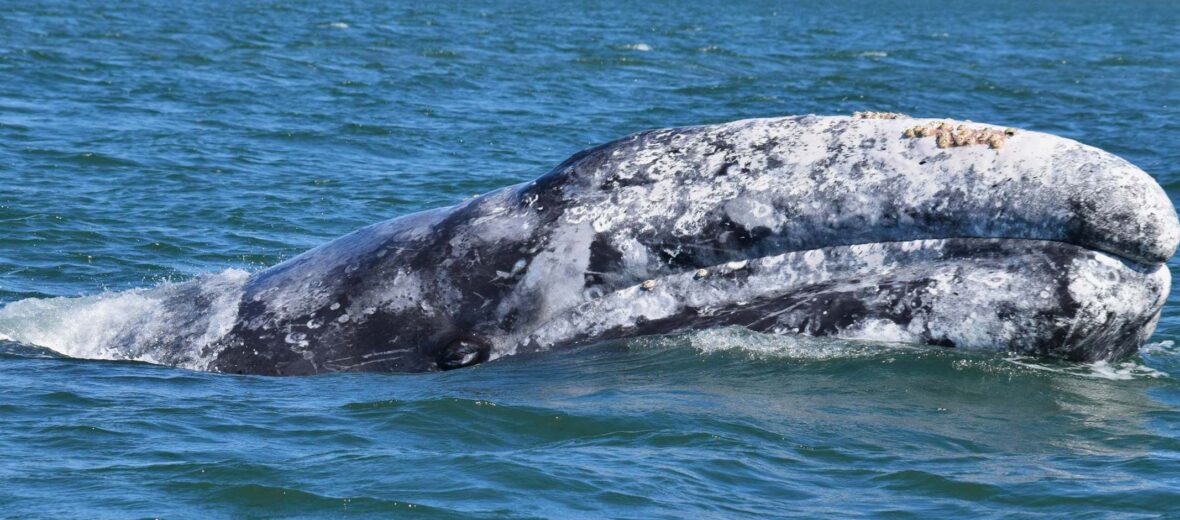
The gray whale, aka gray back whale, Pacific gray whale, & California gray whale, is a migratory whale species that travels farther than any other mammal. There are 2 separate distributions of gray whales in the North Pacific Ocean: the Eastern North Pacific distribution, which calls the west coast of North America home, and the Korean distribution of the Western North Pacific, which calls the coasts of eastern Asia their home. They prefer coastal waters up to 300 feet deep. The eastern group migrates from Arctic waters to Mexican waters, while the western group stays along the east coast of Russia. Fortunately, these critters are listed as Least Concern by the IUCN. They do suffer though at the hands of pollution, overfishing, climate change, and bycatch (getting caught in fishing nets and long lines).
First the Stats…
Scientific name: Eschrichtius robustus
Weight: Up to 60,000 lbs.
Length: Up to 39 feet
Lifespan: Up to 70+ years
Now on to the Facts!
1.) A single whale can carry over 400 lbs of barnacles on their body, fins, and tail.
2.) Gray whales are baleen whales with around 300 baleen plates fixed to their upper jaw.
3.) They weigh as much as up to 60 large cows.
4.) The gray whale is known for exhibiting what is called spyhopping. This is where they raise their head from the water, for some time, to look for other whales and/or predators.
5.) These whales also breach. This is when the whale will leave the water to splash down on their back. It is believed that they do this for communication, entertainment, and to remove parasites from their skin.
But wait, there’s more on the gray whale!
6.) A group of whales is called a pod, a gam, a school, a herd, or a mod.
7.) Besides plankton, these whales feed on crustaceans like ghost shrimp and amphipods. They’ll also eat polychaete worms, herring eggs, and a variety of free-swimming larvae.
Did you know…?
Grays can stay submerged for up to 30 minutes at a time.
8.) Gray whales are polygynandrous (promiscuous) and mate with several partners. Mating and courting often involves 3 or more individuals at the same time. Queue the 70s adult movie music.
9.) After a 13 – 14 month gestation (pregnancy), mom gives birth to a single calf measuring up to 15 feet long and weighing in at around 2,000 lbs.
10.) Females birth their calf in warm, shallow, hyper-saline (extra salty) lagoons that can be as shallow as 12 – 15 feet deep!
But wait, there’s still more on the gray whale!
11.) Whalers often termed gray whale mothers as “devilfish” because of how ferocious they became if separated from their calf.
12.) Gray whales have up to 10 inches of thick blubber to keep them insulated from the cold waters of the Arctic.
Did you know…?
Gray whale migrations can be as far as 14,000 miles!
13.) These whales have 2 blow holes, rather than just 1, like toothed whales.
14.) A gray whale calf can drink up to 300 gallons of milk a day!
15.) They communicate by emitting low pulsing moans, croaks, and whines, that can be heard from great distances under water.
But wait, there’s still a little more on the gray whale!
16.) Their only known predators are orcas and humans (boat strike, entanglement in fishing gear, etc.).
17.) When feeding, these whales will typically tilt to their right side and scoop up food from the ocean floor. This unfortunately can result in blindness in their right eye, in older whales.
18.) Grays sleep (rest) by hanging out just below the surface with their blowhole above water and by laying on the bottom of shallow lagoons.
19.) A young gray whale calf eats, rests, and sleeps while their mother swims ahead of them, towing them along in her slipstream. This is known as echelon swimming.
20.) They have the ability to dive up to 500 feet, but typically dive up to 300 feet.
Now a Short Gray Whale Video!
Be sure to share & comment below! Also, check out the Critter Science YouTube channel. Videos added frequently!
Want to suggest a critter for me to write about? Let me know here.



